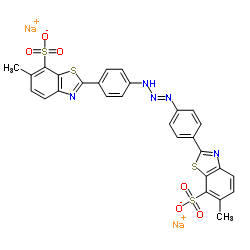Titan Yellow

Titan Yellow structure
|
Common Name | Titan Yellow | ||
|---|---|---|---|---|
| CAS Number | 1829-00-1 | Molecular Weight | 695.720 | |
| Density | N/A | Boiling Point | N/A | |
| Molecular Formula | C28H19N5Na2O6S4 | Melting Point | >250°C | |
| MSDS | Chinese USA | Flash Point | N/A | |
|
Methods for the estimation of serum magnesium in clinical laboratories.
Magnesium 5(5-6) , 317-27, (1986) A variety of methods have been reported for the quantitative analysis of magnesium in serum and other biological fluids. The methods may be classified into the following groups: magnesium ammonium phosphate; 8-hydroxyquinoline; titan yellow; dihydroxyazobenze... |
|
|
Studies on the presence of magnesium in visceral amyloid.
Zentralbl. Pathol. 140(4-5) , 309-15, (1994) The Magneson and Titan yellow tests were used to detect Mg in amyloid deposits in primary and secondary amyloidosis, in a pituitary tumour and in a case of equine cutaneous amyloidosis. Especially vascular amyloid deposits turned out to contain high levels of... |
|
|
Molar absorptivity and the blank correction factor.
Clin. Chem. 31(3) , 462-5, (1985) In photometry, where both the product formed and one or several reactants absorb light at the same wavelength, the absorbance of the "blank" of the sample at the end of the reaction may be less than that measured at the beginning of the reaction, because of c... |
|
|
Resonance Rayleigh scattering spectra of tetracycline antibiotic-Cu(II)-titan yellow systems and their applications in analytical chemistry.
Anal. Bioanal. Chem 385(6) , 1039-44, (2006) Tetracycline antibiotics (TCs) such as doxycycline (DOTC), chlortetracycline (CTC), oxytetracycline (OTC), and tetracycline (TC) react with Cu(II) in pH 3.5 BR buffer medium to form 1:1 cationic chelates, which further react with titan yellow to form 2:1 ion ... |
|
|
[Microdetermination of proteins with Titan yellow by the resonance light scattering method].
Guang Pu Xue Yu Guang Pu Fen Xi 25(6) , 927-9, (2005) A resonance light scattering method for the determination of trace proteins was developed. In the presence of Triton X-100, proteins reacted with Titan yellow to form a combination product, resulting a significant enhancement of resonance light scattering (RL... |
|
|
Color quenching in "environmentally friendly" cocktails.
Health Phys. 73(5) , 808-13, (1997) Fluorescent and colored compounds used in molecular biology labs may generate color quench in wipe test samples taken from such labs. The ability of conventional chemical quench curves to correct for color quench caused by fluorescent and colored compounds in... |